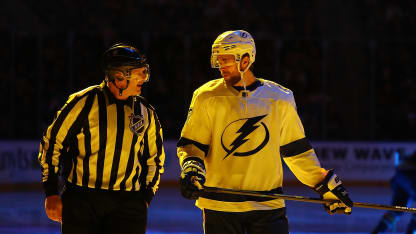Shot Location: This is another area in which Corsi falls short. Not all shots are created equal. Some come from much more dangerous areas of the ice. Coaches, in talking about how their team fared in a game, often focus more on scoring chances - both for and against - than shots. So why doesn't the league track scoring chances? Determining a scoring chance can be tricky, because it's subjective. Coaches on the same staff even may mildly disagree about whether a specific play qualifies as a scoring chance.
But there's no grey area about where a shot originated. In fact, many websites provide a shot chart for each game, pinpointing the exact location of each shot.
What I'd like to see is the following breakdown of shot location. I'd separate the offensive zone into three areas. The first would be a rectangle, running from top of the circles to the faceoff dots on either side and down to the goal line. The second would be above the top of the circles - shots from the point. The third would be below the top of the circles, but outside the dots. Area one is where, typically, the best scoring chances originate. Area two is less prime, but point shots can be effective when the goalie is screened. Area three is the least dangerous. A small number of shots might come from outside the blue line, but those could fall into an "other" category.
A team that likes to put pucks on net could have a greater ratio of shots from area three. Its Corsi numbers may be strong, but area three shots are low percentage attempts (although they may lead to a rebound and scramble play from area one). Knowing the percentage of shots - or even attempts - from each of those three areas can tell us a lot about shot volume vs. shot quality.
Clearing Pucks On Penalty Kill: One of the more critical aspects of a successful penalty kill is clearing pucks. When a penalty killer collects the puck in the defensive zone and attempts a clear, there are three possible outcomes. First, he is successful and the power play unit has to retrieve the puck in its own end. Second, the attempt is unsuccessful. The power play team disrupts the clear - or blocks it - so the puck stays in the attacking zone. Third, the puck neither goes down the ice nor does it stay in the offensive zone. It is fired into a bench, is deflected out of play (or not deflected, leading to a penalty), or is partially blocked and ends up coming out only as far as the neutral zone.
Good penalty killing teams consistently clear pucks down the ice when they have a chance. I'd love to see that percentage tracked. In order to qualify, all skaters from both sides have to be in the attacking zone and a penalty killer must make an attempt to clear. How many pucks get down the ice, how many don't leave the zone, and how many have an "other" outcome?
Of course, this number could be tracked for power play units too. How effective is a team at disrupting or intercepting clearing attempts while they are on the man advantage?
Entering the Offensive Zone While On the Power Play: Another important component to good penalty killing is what happens after the puck is cleared. Penalty killers want to prevent the other side from re-entering the zone.
On a regroup that originates from the power play team's defensive zone, is the power play group able to enter the offensive zone with possession and set up? In my book, a goal off the rush would count as a "yes". An entry that results in an immediate penalty kill steal and clear counts as a "no".
Similar to the previous category, this percentage can be tracked for both power play and PK units.
Odd-Man Rushes: In addition to tracking scoring chances, coaches tabulate odd-man rushes when reviewing video. Teams aim to limit the number of odd-man rushes allowed. These can result from offensive or neutral zone turnovers, leaky rush coverage, and/or a poorly-timed line change.
I'd like to see the number of odd-man rushes tracked, both for and against. A clear three-on-two, two-on-one, or breakaway. Then, what happened? Shot on net for a goal? Shot on net with a save? Attempted shot that didn't go on net? Or no shot (defensive team broke it up or miscue on execution from offensive team)?
When a club laments that it's yielding too many odd-man rushes, what's the actual number? How many saves does a goalie make on those plays? For the attacking players, how often did they convert for a goal? On the flip side for that team, how many odd-man rushes didn't even yield a shot attempt?
So for now, these five categories came to mind. I have a hunch that as the league tracking data becomes mainstream, there will be other interesting nuggets that I haven't even considered.



















